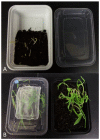An Optimized Small-Scale Rearing System to Support Embryonic Microinjection Protocols for Western Corn Rootworm, Diabrotica virgifera virgifera
- PMID: 37623393
- PMCID: PMC10455090
- DOI: 10.3390/insects14080683
An Optimized Small-Scale Rearing System to Support Embryonic Microinjection Protocols for Western Corn Rootworm, Diabrotica virgifera virgifera
Abstract
Western corn rootworm (WCR), a major pest of corn, has been reared in laboratories since the 1960s. While established rearing methods are appropriate for maintaining WCR colonies, they are not optimal for performing germline transformation or CRISPR/Cas9-based genome editing. Here we report the development of an optimized rearing system for use in WCR functional genomics research, specifically the development of a system that facilitates the collection of preblastoderm embryos for microinjection as well as gathering large larvae and pupae for downstream phenotypic screening. Further, transgenic-based experiments require stable and well-defined survival rates and the ability to manipulate insects at every life stage. In our system, the WCR life cycle (egg to adult) takes approximately 42 days, with most individuals eclosing between 41 and 45 days post oviposition. Over the course of one year, our overall survival rate was 67%. We used this data to establish a quality control system for more accurately monitoring colony health. Herein, we also offer detailed descriptions for setting up single-pair crosses and conducting phenotypic screens to identify transgenic progeny. This study provides a model for the development of new rearing systems and the establishment of highly controlled processes for specialized purposes.
Keywords: CRISPR; function genomics; insect rearing; molecular biology; rootworm.
Conflict of interest statement
The authors declare no conflict of interest.
Figures







References
-
- Gray M.E., Sappington T.W., Miller N.J., Moeser J., Bohn M.O. Adaptation and invasiveness of western corn rootworm: Intensifying research on a worsening pest. Annu. Rev. Entomol. 2009;54:303–321. - PubMed
-
- Georce B.W., Ortman E.E. Rearing the western corn rootworm in the laboratory. J. Econ. Entomol. 1965;58:375–377. doi: 10.1093/jee/58.2.375. - DOI
-
- Bigger J., March R. Rearing southern corn rootworms on seedling corn plants. J. Econ. Entomol. 1943;36:349–350. doi: 10.1093/jee/36.2.349. - DOI
-
- Branson T.F., Guss P., Krysan J., Sutter G. Corn Rootworms: Laboratory Rearing and Manipulation. US Department of Agriculture, National Agricultural Library; Washington DC, USA: 1975.
-
- Branson T.F., Jackson J.J., Sutter G.R. Improved method for rearing Diabrotica virgifera virgifera (Coleoptera, Chrysomelidae) J. Econ. Entomol. 1988;81:410–414. doi: 10.1093/jee/81.1.410. - DOI
Grants and funding
LinkOut - more resources
Full Text Sources

